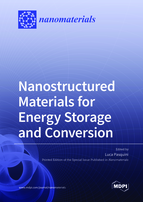Nanostructured Materials for Energy Storage and Conversion
A special issue of Nanomaterials (ISSN 2079-4991). This special issue belongs to the section "Energy and Catalysis".
Deadline for manuscript submissions: closed (31 May 2021) | Viewed by 29988
Special Issue Editor
Interests: nanoparticles; alloys; grain boundaries; nanostructured materials; hydrogen storage; magnesium; material characterization; X-ray diffraction; microstructure
Special Issues, Collections and Topics in MDPI journals
Special Issue Information
Dear Colleagues,
The conversion and storage of renewable energy sources is an urgent challenge we have to confront in order to transition from a fossil fuel based economy to a low-carbon society. The development of new materials with improved characteristics is a key issue to enable this epochal transformation. Nanostructured materials, by virtue of their high surface-to volume ratio and short migration distances, are an attractive solution to achieve higher conversion efficiencies as well as enhanced power and energy density.
The aim of this special issue is to collect state-of-the-art contributions related to various applications of nanomaterials in the field of energy conversion and storage. Examples include, but are not limited to, electrode and electrolyte materials for batteries, supercapacitors, solid-state hydrogen storage, nanostructured solar cells, heterogeneous catalysts, artificial photosynthesis, and plasmonics. Nanoscale features should be central to the properties of materials discussed in the manuscripts. The authors are encouraged to highlight the advantageous features of nanomaterials as well as to address their current limitations and challenges.
Prof. Luca Pasquini
Guest Editor
Manuscript Submission Information
Manuscripts should be submitted online at www.mdpi.com by registering and logging in to this website. Once you are registered, click here to go to the submission form. Manuscripts can be submitted until the deadline. All submissions that pass pre-check are peer-reviewed. Accepted papers will be published continuously in the journal (as soon as accepted) and will be listed together on the special issue website. Research articles, review articles as well as short communications are invited. For planned papers, a title and short abstract (about 100 words) can be sent to the Editorial Office for announcement on this website.
Submitted manuscripts should not have been published previously, nor be under consideration for publication elsewhere (except conference proceedings papers). All manuscripts are thoroughly refereed through a single-blind peer-review process. A guide for authors and other relevant information for submission of manuscripts is available on the Instructions for Authors page. Nanomaterials is an international peer-reviewed open access semimonthly journal published by MDPI.
Please visit the Instructions for Authors page before submitting a manuscript. The Article Processing Charge (APC) for publication in this open access journal is 2900 CHF (Swiss Francs). Submitted papers should be well formatted and use good English. Authors may use MDPI's English editing service prior to publication or during author revisions.
Keywords
- energy storage
- energy conversion
- nanostructures
- interfaces
- size effects
- (photo)electrochemistry
- hydrogen
- solar fuels
- nanocatalysts
- plasmonics







